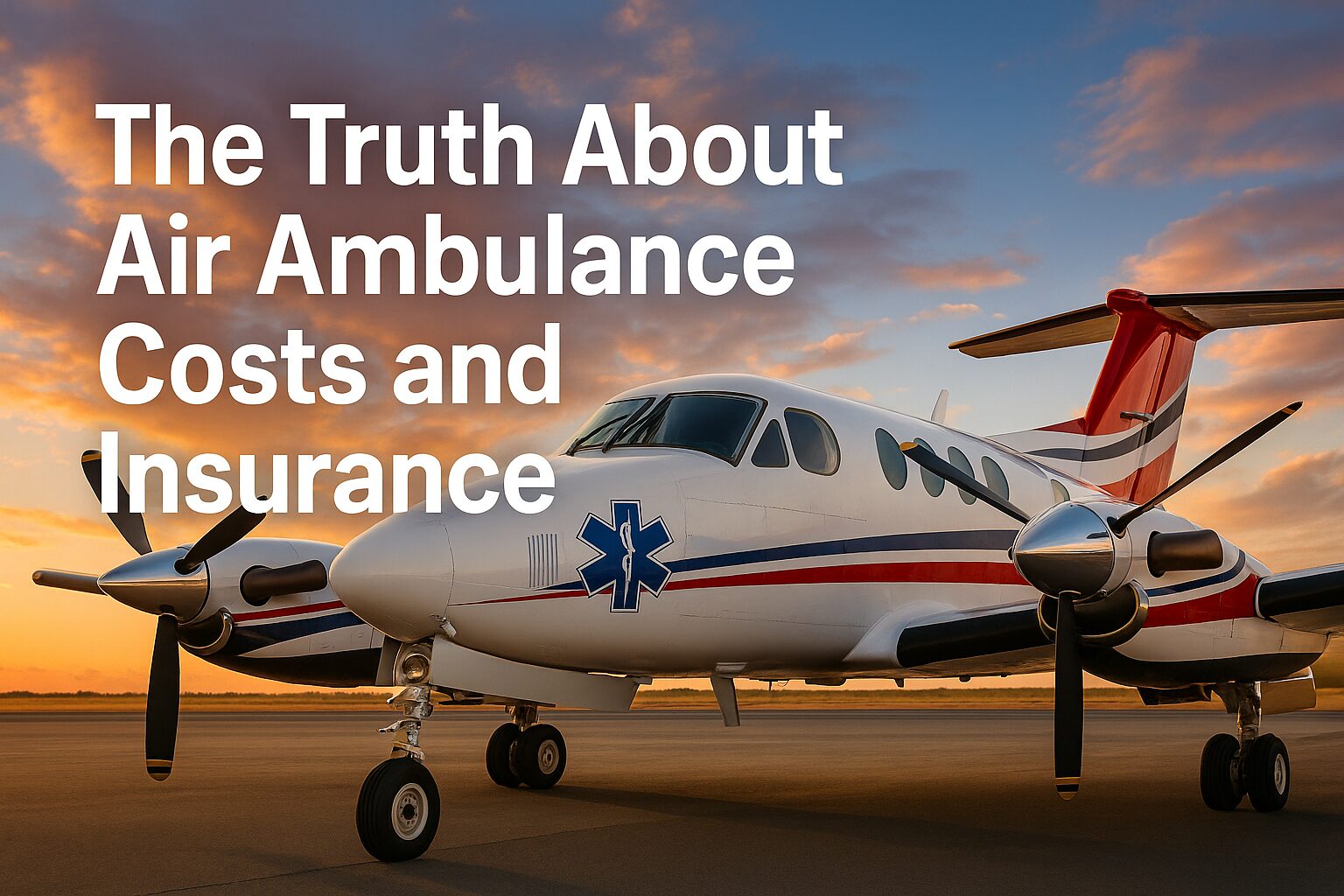Emergencies don’t announce themselves. When an unexpected medical crisis strikes far from home—whether on a remote highway, a mountain trail, or even abroad—you need rapid assistance. An air ambulance rescue can literally be the difference between life and death. But these critical services come at a steep price, often ranging from tens to hundreds of thousands of dollars. That’s where air ambulance insurance steps in, ensuring you’re not left footing a catastrophic bill in moments of crisis.
In this guide, we’ll delve into why air ambulance insurance matters, explore coverage options, outline common scenarios, and equip you with actionable tips to choose the right plan. Along the way, we’ll highlight frequently asked questions such as “Does health insurance cover ambulance?” and “Is air evac insurance worth it?” so you can travel with confidence, knowing help is only a phone call away.
Why Air Ambulance Rescues Matter
- Speedy Evacuation Saves Lives
- When ground transport is too slow (severe trauma, stroke, heart attack), a helicopter ambulance or fixed-wing air medical flight can reach you in minutes.
- Remote or hostile environments (mountains, deserts, offshore rigs) often lack timely hospital access. An air medical transport bridges that gap instantly.
- Specialized Medical Care En Route
- Air medical transport insurance covers not just the flight but the onboard critical care team—paramedics, nurses, or even physicians—ready to stabilize you midair.
- Equipment onboard (ventilators, cardiac monitors, infusion pumps) mirrors an intensive care unit, giving you the best chance of recovery during transit.
- Financial Protection in the Unpredictable
- Without medical air transport insurance, a single airlift can cost anywhere from $10,000 to over $200,000, depending on distance and medical complexity.
- Even basic “ground ambulance” riders rarely cover high-altitude or long-distance evacuations. You need a dedicated air medical insurance plan.
Anatomy of Air Ambulance Insurance
Most air ambulance insurance policies fall into one of these categories:
- Standalone Air Ambulance Plans
- Also called medical helicopter insurance or helicopter ambulance insurance, these policies focus solely on covering emergency air transport.
- Ideal for adventure travelers, remote workers, and anyone with a high-risk lifestyle (e.g., mountaineers, deep-sea fishermen).
- Add-On Riders to Travel or Health Insurance
- Some travel policies offer optional airmed insurance extensions. Others embed limited coverage under the “emergency medical evacuation” clause.
- Check specifically for “medical air ambulance insurance” or “airlift northwest membership” options to ensure comprehensive protection.
- Membership-Based Air Evac Services
- Programs such as “Care Flight Insurance” or “Flight Life Insurance Only” operate on a subscription model—annual or per-trip fees.
- Often include perks like airlift northwest membership, zero out‐of‐pocket for covered missions, and access to global dispatch centers.
What Influences Air Ambulance Insurance Cost
- Geographic Scope
- Domestic-only plans are cheaper but won’t cover international rescues. An international air ambulance insurance policy is pricier but essential if you travel overseas.
- Domestic-only plans are cheaper but won’t cover international rescues. An international air ambulance insurance policy is pricier but essential if you travel overseas.
- Coverage Limits & Deductibles
- Policies may cap reimbursement (e.g., $50,000 per evacuation) or require a deductible before they kick in. Ask “What’s my air ambulance coverage ceiling?”
- Policies may cap reimbursement (e.g., $50,000 per evacuation) or require a deductible before they kick in. Ask “What’s my air ambulance coverage ceiling?”
- Type of Aircraft
- Rotor-wing (helicopter) vs. fixed-wing (jet) costs differ dramatically. A short-range helicopter medical transport insurance ride may cost $20,000, while a global medevac jet can reach $150,000+.
- Rotor-wing (helicopter) vs. fixed-wing (jet) costs differ dramatically. A short-range helicopter medical transport insurance ride may cost $20,000, while a global medevac jet can reach $150,000+.
- Membership vs. Per-Use
- A “per-use” policy charges only when you fly but often carries unpredictable premiums. A membership model (e.g., “is air evac insurance worth it?”) locks in a fixed annual rate.
Core Coverage Components to Look For
- Emergency Airlift & Medical Crew
- Does the plan include nurse/paramedic accompaniment?
- Are advanced life support (ALS) interventions (intubation, mechanical ventilation) covered?
- Ground-to-Air & Hospital Transfers
- Will they cover ambulance-to-helicopter and helicopter-to-hospital transfers?
- Some insurers exclude “last-mile” ground transport, forcing you to pay out of pocket.
- Repatriation & Return of Remains
- “Does health insurance cover helicopter transport back home?” Usually not. Look specifically for “air ambulance repatriation” and “repatriation of remains” benefits.
- International plans should include medically supervised return flights to your home country.
- Accidental Death & Dismemberment (AD&D) Rider
- While primarily life insurance, AD&D riders occasionally pair with medevac plans to provide lump-sum benefits if the worst happens in transit.
- While primarily life insurance, AD&D riders occasionally pair with medevac plans to provide lump-sum benefits if the worst happens in transit.
- Coverage for Dependents & Family Members
- If you’re traveling with children or an elderly parent, ensure they’re covered under the same air ambulance insurance policy. Some plans require separate premiums for each member.
Common Scenarios & How Insurance for Air Ambulance Responds
Scenario 1: Hiker With Compound Fracture in the Rockies
You’re scaling a remote trail at high altitude when you slip off a ledge. The nearest trauma center is 100 miles away on narrow mountain roads.
- Solution: A helicopter ambulance arrives within 30 minutes, lifts you to a level-I trauma center, and the cost (flight crew, fuel, aircraft fees) is fully covered under your helicopter ambulance insurance plan.
Scenario 2: Medical Emergency in a Foreign Country
While vacationing abroad, you suffer a life-threatening cardiac event on a cruise ship docked in a remote port city. Local hospitals lack advanced cardiac catheterization labs.
- Solution: Activated under “international air ambulance insurance,” a fixed-wing jet is dispatched. You receive onboard critical care and are flown first to a regional hub, then repatriated to a U.S. hospital. The total bill of $200,000 is covered per your medical air transport insurance policy.
Scenario 3: Motorcycle Accident in Rural Southeast Asia
A collision leaves you with internal bleeding. The local clinic can only stabilize you. The nearest ICU is a full day’s journey by road.
- Solution: Emergency dispatcher arranges a medevac helicopter. Thanks to air ambulance insurance coverage, you incur no out‐of‐pocket expenses for the $60,000 flight.
Does Health or Travel Insurance Cover Air Ambulance?
- Standard Health Plans
- Most employer-sponsored health plans exclude “non-emergency” air transports; even “emergency” may only cover ground ambulances.
- Ask explicitly: “Does my health insurance cover helicopter transport or fixed-wing medical flights?”
- Travel Insurance with Evacuation Riders
- Many travel policies include a lump-sum “medical evacuation” benefit, but limits can be low (e.g., $50,000).
- To avoid gaps, buy a stand-alone air ambulance travel insurance rider or a comprehensive medical air ambulance insurance plan.
- Charity or Government-Sponsored Programs
- In some countries, military or charitable organizations subsidize airlifts—rarely enough for complex international repatriations.
Tips to Ensure You’re Fully Covered
- Buy Early
- Purchase air ambulance insurance as soon as you book your trip. Some policies enforce a waiting period—typically 48–72 hours before coverage activates.
- Purchase air ambulance insurance as soon as you book your trip. Some policies enforce a waiting period—typically 48–72 hours before coverage activates.
- Verify Exclusions & Sublimits
- Read the fine print for “air ambulance coverage exclusions.” Common culprits: extreme sports injuries (base jumping, heli-skiing), injuries under intoxication, and pre-existing conditions.
- Read the fine print for “air ambulance coverage exclusions.” Common culprits: extreme sports injuries (base jumping, heli-skiing), injuries under intoxication, and pre-existing conditions.
- Compare Multiple Providers
- Use comparison sites or consult an independent broker to evaluate:
- Air ambulance insurance cost
- Membership vs. per-use premiums
- Geographic scope (domestic vs. global)
- Onboard medical staffing levels
- Use comparison sites or consult an independent broker to evaluate:
- Check Network Affiliations
- Some air med insurance plans mandate using specific air operators. If you’re in a remote area, verify there’s an affiliated vendor nearby.
- Some air med insurance plans mandate using specific air operators. If you’re in a remote area, verify there’s an affiliated vendor nearby.
- Confirm 24/7 Dispatch & Language Support
- Emergencies don’t keep office hours. Ensure your insurer’s dispatch center is always reachable—ideally with multilingual staff for overseas crises.
- Emergencies don’t keep office hours. Ensure your insurer’s dispatch center is always reachable—ideally with multilingual staff for overseas crises.
- Document All Policy Numbers & Contacts
- Store digital and physical copies of your air ambulance insurance ID, membership number, and emergency contact details. Share these with your travel companions.
Frequently Asked Questions
- Is Life Flight Covered by Insurance?
- Often not by default. Life Flight is a generic term for any critical care air transport. Check for a specific “life flight” or “medflight” rider in your policy. Many major carriers (e.g., Blue Cross Blue Shield) require a separate “med flight insurance” add-on.
- Often not by default. Life Flight is a generic term for any critical care air transport. Check for a specific “life flight” or “medflight” rider in your policy. Many major carriers (e.g., Blue Cross Blue Shield) require a separate “med flight insurance” add-on.
- How Much Does an Air Ambulance Cost with Insurance?
- With a comprehensive air ambulance insurance plan, your out-of-pocket cost is zero for covered missions. Without insurance, short-haul flights start around $20,000, while intercontinental evacuations can exceed $150,000.
- With a comprehensive air ambulance insurance plan, your out-of-pocket cost is zero for covered missions. Without insurance, short-haul flights start around $20,000, while intercontinental evacuations can exceed $150,000.
- Is Air Ambulance Insurance Worth It?
- If you travel frequently, engage in high-risk activities, or visit remote regions, the peace of mind alone makes it worth the premium. A single rescue can bankrupt you without proper coverage.
- If you travel frequently, engage in high-risk activities, or visit remote regions, the peace of mind alone makes it worth the premium. A single rescue can bankrupt you without proper coverage.
- Does Medical Insurance Cover Ambulance?
- Ground ambulance rides are commonly covered under health plans, but “Does medical insurance cover helicopter transport?” is almost always answered with “No.” For that, you need helicopter medical insurance specifically.
- Ground ambulance rides are commonly covered under health plans, but “Does medical insurance cover helicopter transport?” is almost always answered with “No.” For that, you need helicopter medical insurance specifically.
- What’s the Difference Between “Airlift Northwest Membership” and Standard Policies?
- Membership programs (e.g., Airlift Northwest, Care Flight Insurance, Airlink Insurance) often operate as non-profit collectives: members pay annual dues, and when you need a flight, members cover the gap between actual costs and insurance payouts. Standard policies pay per event.
- Membership programs (e.g., Airlift Northwest, Care Flight Insurance, Airlink Insurance) often operate as non-profit collectives: members pay annual dues, and when you need a flight, members cover the gap between actual costs and insurance payouts. Standard policies pay per event.
- Does Insurance Cover Life Flight for International Evacuations?
- Only if you purchase an international air ambulance insurance rider. Domestic-only plans rarely reimburse cross-border lifts.
Conclusion
Emergencies rarely wait for convenience. Whether you’re trekking in the Himalayas or conducting business overseas, having robust air ambulance insurance is not a luxury—it’s a necessity. By understanding the types of medical air transport insurance, comparing costs, and verifying all policy details, you safeguard yourself, your loved ones, and your finances against unforeseen disasters.
Remember to buy early, confirm your coverage limits, and archive all critical contact information. When a crisis unfolds, the last thing you want to worry about is how to pay for a life-saving flight. With the right plan in place, you can act decisively, knowing you—and those you travel with—are protected.




